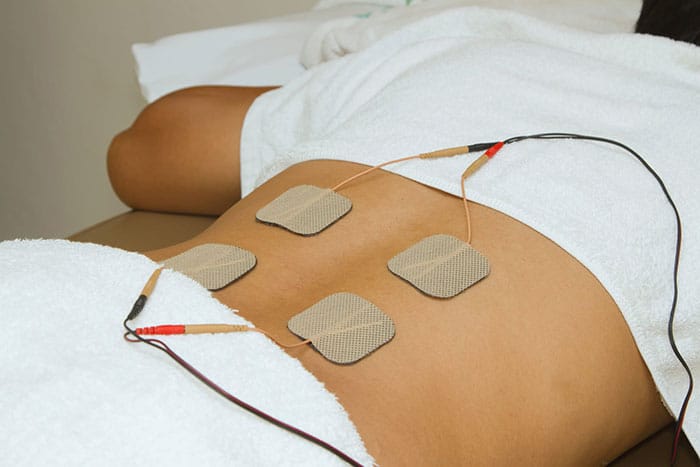Can Electrical Stimulation Techniques Provide Pain Reduction?

This article examines the potential of electrical stimulation techniques in providing pain reduction.
The introduction provides an overview of electrical stimulation techniques and their mechanism of action in pain management. It explores the different types of electrical stimulation used for pain reduction and discusses their benefits and limitations.
Furthermore, it presents research and evidence on the effectiveness of electrical stimulation techniques in relieving pain.
The objective and impersonal tone of the article ensures a comprehensive analysis of the topic.
Key Takeaways
- Electrical stimulation techniques, such as TENS and SCS, can provide pain reduction for various chronic pain conditions.
- These techniques modulate neural pathways involved in pain processing and primarily target the gate control theory of pain.
- Electrical stimulation offers targeted pain relief, decreases reliance on medications, and promotes the release of natural pain-relieving substances.
- Research and evidence support the effectiveness of electrical stimulation techniques for pain management, with numerous studies and clinical trials demonstrating positive results.
Overview of Electrical Stimulation Techniques
Electrical stimulation techniques encompass various modalities that aim to alleviate pain through the application of electrical current. These techniques have seen advancements in technology over the years, leading to improved outcomes in pain management.
One key advantage of electrical stimulation techniques is their non-invasive nature, which reduces the risk of complications compared to surgical interventions. Additionally, electrical stimulation can be used as an adjunct therapy alongside other pain management techniques, such as medication or physical therapy. This combination approach has shown promising results in achieving better pain relief and functional outcomes for patients.
Compared to other techniques, electrical stimulation offers a more targeted approach to pain relief, allowing for specific areas of the body to be targeted for treatment.
Overall, electrical stimulation techniques have evolved to become a valuable tool in the management of pain, providing patients with an alternative or complementary option to traditional pain management methods.
Understanding the Mechanism of Pain Reduction
Understanding the mechanism by which pain is reduced through the use of electrical stimulation techniques is a crucial aspect of research in this field. Pain perception involves a complex interplay between various neural pathways involved in pain processing.
Electrical stimulation techniques, such as transcutaneous electrical nerve stimulation (TENS) and spinal cord stimulation (SCS), aim to modulate these pathways to alleviate pain. TENS works by delivering low-voltage electrical impulses to the skin, which activates the large-diameter sensory fibers, leading to the inhibition of pain signals.
On the other hand, SCS involves the placement of electrodes near the spinal cord to deliver electrical pulses that interfere with pain signals’ transmission. Both techniques are thought to primarily target the gate control theory of pain, which suggests that the electrical stimulation can interfere with the transmission of pain signals in the spinal cord.
The exact mechanisms underlying the pain reduction achieved by electrical stimulation techniques are still being investigated, and further research is needed to fully understand their effectiveness and potential applications.
Different Types of Electrical Stimulation for Pain Management
Different types of electrical stimulation methods have been developed and studied for their potential applications in managing pain. These methods include:
- Transcutaneous Electrical Nerve Stimulation (TENS) therapy: TENS therapy involves the use of low-voltage electrical currents to stimulate the nerves and provide pain relief. It is commonly used for chronic pain conditions such as arthritis, back pain, and fibromyalgia.
- Spinal Cord Stimulation (SCS): SCS involves the implantation of electrodes near the spinal cord to deliver electrical pulses. These pulses interfere with the transmission of pain signals to the brain, providing relief for conditions such as failed back surgery syndrome and complex regional pain syndrome.
- Peripheral Nerve Stimulation (PNS): PNS involves the placement of electrodes near peripheral nerves to deliver electrical stimulation. It is effective in managing chronic neuropathic pain and has shown promising results in conditions such as post-amputation pain and peripheral neuropathy.
These electrical stimulation techniques offer alternative options for pain management and have shown promising results in providing relief for various chronic pain conditions.
Benefits and Limitations of Electrical Stimulation for Pain Reduction
The benefits and limitations of utilizing electrical stimulation methods for managing chronic pain have been extensively explored and documented in various studies.
One of the major advantages of electrical stimulation techniques is their ability to provide targeted pain relief by directly stimulating the nerves involved in pain transmission. This can lead to decreased reliance on medications and their associated side effects.
Additionally, electrical stimulation methods have been found to promote the release of endorphins, which are natural pain-relieving substances produced by the body.
However, there are also drawbacks to consider. Some individuals may experience discomfort or skin irritation at the site of stimulation. Furthermore, the effectiveness of electrical stimulation techniques can vary among individuals, and they may not provide complete pain relief for everyone.
Despite these limitations, electrical stimulation methods continue to be a promising avenue for pain management, especially when used in combination with other therapeutic approaches.
Research and Evidence on the Effectiveness of Electrical Stimulation Techniques
Research and evidence on the effectiveness of utilizing electrical stimulation methods for managing chronic pain have been extensively explored and documented in various studies. These evidence-based studies and clinical trials have provided valuable insights into the efficacy of electrical stimulation techniques in reducing pain.
The following sub-lists highlight the key findings from these studies:
- Electrical stimulation methods, such as transcutaneous electrical nerve stimulation (TENS), have shown promising results in reducing pain intensity and improving overall quality of life in individuals with chronic pain.
- Clinical trials have demonstrated that electrical stimulation techniques can effectively target specific areas of pain, providing localized pain relief.
- Furthermore, evidence suggests that electrical stimulation can modulate pain perception by stimulating the release of endogenous opioids and activating descending pain inhibitory pathways.
Overall, the research and evidence from numerous studies and clinical trials support the use of electrical stimulation techniques as a viable option for managing chronic pain.
Frequently Asked Questions
What Are Some Common Conditions That Can Be Treated With Electrical Stimulation Techniques?
Conditions suitable for treatment with electrical stimulation techniques include chronic pain, musculoskeletal disorders, nerve injuries, and postoperative pain. Efficacy comparison studies have shown positive outcomes in reducing pain intensity and improving functional outcomes in these conditions.
Are There Any Potential Side Effects or Risks Associated With Electrical Stimulation for Pain Management?
Potential risks and safety concerns associated with electrical stimulation techniques for pain management need to be investigated. It is important to assess the potential side effects and ensure the safety of such interventions before widespread implementation.
How Long Does It Typically Take for Electrical Stimulation Techniques to Provide Pain Relief?
The effectiveness and duration of pain relief provided by electrical stimulation techniques vary depending on the specific method used. Different types of electrical stimulation techniques can be compared to determine their relative efficacy and duration of pain relief.
Can Electrical Stimulation Be Used as a Standalone Treatment or Is It Usually Combined With Other Therapies?
Combining electrical stimulation with other therapies is a common practice, as it is believed to enhance the overall effectiveness of pain management. However, there is also evidence suggesting potential benefits of electrical stimulation as a standalone treatment.
Are There Any Specific Patient Groups or Individuals Who May Not Be Suitable Candidates for Electrical Stimulation Techniques?
Potential contraindications for electrical stimulation techniques should be considered. Alternative pain management options may be necessary for individuals who are not suitable candidates for these techniques.









